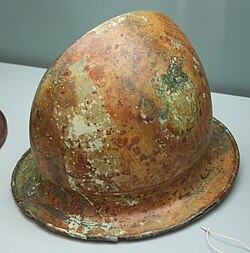Negau helmets
This article needs additional citations for verification. (December 2010) |

The Negau helmets are 26 bronze
Inscriptions
On one of the helmets ("Negau B"), there is an inscription in a
- 𐌇𐌀𐌓𐌉𐌙𐌀𐌔𐌕𐌉𐌕𐌄𐌉𐌅𐌀///𐌉𐌐
- hariχastiteiva\\\ip
Many interpretations of the inscription have been proffered in the past, but the most recent interpretation is by Tom Markey (2001), who reads the inscription as Hariχasti teiva, 'Harigast the priest' (from *
This inscription has been of particular interest to historical linguists, since it has been argued that it provides the earliest attestation of Grimm's law (also known as the First Germanic Sound Shift), the sound shift which distinguishes the Germanic languages from other Indo-European languages. If teiva is a Germanic cognate of Latin deus 'god', it would reflect Grimm's shift *d > *t. This would be the earliest attestation of the shift, which would have relevance for the dating. However Smith[who?] argues that there are major problems[further explanation needed] with seeing the helmet as conclusive evidence for such a development.[1]
The four discrete inscriptions on the helmet usually called "Negau A" are read by Markey (2001) as: Dubni banuabi 'of Dubnos the pig-slayer'; sirago turbi 'astral priest of the troop'; Iars'e esvii 'Iarsus the divine'; and Kerup, probably an abbreviation for a Celtic name like Cerubogios.
See also
References
- ^ ISBN 978-0-521-86677-4.
- Markey, Tom (2001). "A Tale of Two Helmets: The Negau A and B Inscriptions". Journal of Indo-European Studies. 29 (1/2): 69–172.
- Teržan, B. 2012. ‘Negau (Negova), Slowenien: Benedikt V’, in S. Sievers, O.H. Urban and P.C. Ramsal (eds.), Lexikon zur keltischen Archäologie, pp. 1357-59. Vienna.
External links
- "The Negau helmet". TITUS (project). 2001.
